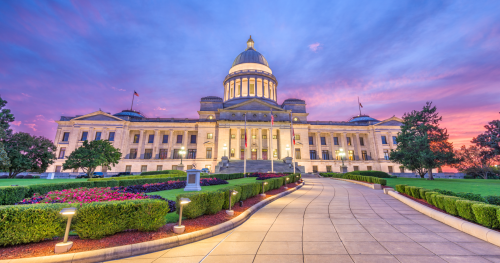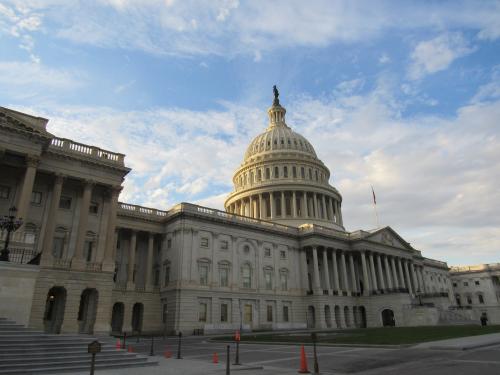Conventional wisdom holds that last year’s bipartisan passage of the Infrastructure Investment and Jobs Act (IIJA) reflects the tradition of both parties wanting to deliver better roads and bridges—with nothing new to tell us about making progress elsewhere in our polarized, partisan environment. If anything, infrastructure is the exception that (barely) proves the rule of the current difficulty in finding common ground to meet new challenges.
Perhaps this conventional wisdom is accurate. But one section of that legislation defied both the anchors of history and the dominant political dynamics of the moment: the $65 billion allocated to broadband.
Unlike roads, bridges, ports, water systems, and transit, broadband was the only infrastructure Congress funded that had not been subject to multiple prior bipartisan spending efforts. One can dismiss this difference on the grounds that the physical nature of broadband is similar enough to projects in prior infrastructure legislation that including it was not a great leap. Still, unlike transportation and water systems, broadband is primarily funded by private capital. So, Congress made an uncommon decision that broadband had entered a rare bucket of essential services which justify government support—and further, that private markets were not going to provide those services in some areas without significant government assistance.
The congressional funding debate between “hard” and “soft” infrastructure also points to an important difference between broadband and other infrastructure. Early in the IIJA debate, Republican senators insisted that they would not support “soft” infrastructure, consisting of services designed to help people. Broadband turned out to be a major exception: The $65 billion broadband appropriation included $17 billion to support low-income persons seeking to purchase broadband, as well as digital literacy programs and other critical services for new users. In fact, the percentage of “soft” infrastructure spending in the final bill was more than double the percentage of earlier Democratic versions of the broadband provisions.
A third way the broadband debate was different is that, unlike many issues which have been increasingly viewed through a racialized lens, here the issue was less racialized than in the past. The soft infrastructure spending on low-income support is essentially an augmentation of the Federal Communications Commission’s (FCC) Lifeline program established by the Reagan administration, which provided support for wired phone service and, later, cell phone service. The program was relatively non-controversial until Barack Obama was elected, when the $10 monthly subsidy was suddenly subject to a number of Fox News stories that played into racist stereotypes. The IIJA provides a subsidy three times greater than Lifeline and directly acknowledges that part of its purpose is to address racial inequity. But the provisions did not raise the kind of attacks our increasingly racialized political debate encourages.
So why is it that broadband has inspired more political collegiality than many other issues?
One overlooked bipartisan success story that contributed to the IIJA’s broadband progress was the Obama FCC’s reform of E-Rate—a program designed to assist schools, libraries, and health care facilities obtain broadband access. While the FCC passed the reforms on a partisan vote, it was implemented in a bipartisan way. There was a concerted effort, led by the nonprofit Education Superhighway, to get all 50 state governors to understand the reforms, take advantage of the new funding, and achieve the goal of connecting every school to the fiber optic connections needed to meet future connectivity needs. The effort succeeded, and in the process, governors enhanced their understanding of broadband deployment, built state capacity for addressing broadband deficits, and became advocates of federal broadband support.
Early bipartisan versions of the IIJA’s broadband provisions also aided the bill’s eventual passage, including the BRIDGE Act, proposed by Sen. Michael Bennet (D-Colo.), Sen. Angus King (I-Maine), and Sen. Rob Portman (R-Ohio). Personal skills played a role too, with Sen. Susan Collins (R-Maine) praising Commerce Secretary Gina Raimondo for bringing “a very practical governor’s approach to the issues.” It helped that conservative think tanks generally favor voucher programs to assist low-income persons in accessing communications services. And support for greater federal involvement from both rural and urban interests was important.
But possibly the biggest impact was the fallout from COVID-19. Congress, in passing the legislation, wrote that the “2019 novel coronavirus pandemic has underscored the critical importance of affordable, high-speed broadband for individuals, families, and communities to be able to work, learn, and connect remotely while supporting social distancing.”
The pandemic experience touched every American. While it touched us all unequally, it nonetheless created a sense of democratic empathy, which New York Times columnist Jamelle Bouie defined as being “able to see ourselves in one another to be able to see one another as political equals.” Perhaps it was this democratic empathy that caused Republicans—traditionally skeptical of government interventions in markets—to support increased government action in broadband at both the federal and state level and through increased subsidies for expanded deployment and low-income adoption.
Will this era of good feelings in broadband policy continue? That will be tested. The IIJA’s broadband provisions mark a historic moment, but not the end of the journey.
First, there must be a permanent solution to broadband affordability for low-income persons. Some have argued that as telephone companies and new entrants deploy fiber to compete with cable broadband services, entry-level prices will drop to a level that will make broadband affordable to all. Such competition is good, but the data is clear: Fiber competition with cable does not cause an increase in low-income adoption. That should not be surprising as, from the fiber company’s perspective, the purpose of fiber deployments is to compete with cable to capture revenues from customers desiring higher performance, who generally enjoy higher incomes.
Fortunately, Congress instructed the FCC to come up with a plan to reform its universal service program, which currently provides much lower levels of subsidies to support network deployment in rural areas, and to make communications services affordable to low-income persons. That is now underway, prompting a thoughtful debate on how best to ensure that all Americans have the tools necessary to fully participate in the economic and social life of their communities.
Second, there must be a greater effort to consider how to use broadband to improve how industries deliver essential services, including health care, education, workforce development, and general government services. While there are numerous state and federal efforts to do so, those still lack a systemic approach that will be necessary to achieve that goal.
Our political leadership should be proud of how they applied the lessons of the pandemic and utilized unifying messages to build political capital for expanding broadband network coverage and, at least in the near term, increasing broadband adoption. Will they be able to do so for the next set of broadband challenges? Logically, those lessons should apply equally to a long-term solution for adoption. Further, it should not be difficult to harness similar arguments to improving how essential services are delivered; indeed, it should be easier, as improving the delivery of essential services over digital networks benefits many more than just those previously on the wrong side of the digital divide.
Still, whether the democratic empathy that characterized last year’s broadband debates will continue in the future remains an open question. Memories of our pandemic experience may fade, and our current political culture seems to reward messages of fear of the other, rather than empathy. As we move forward to advance the rights of all to fully participate in the digital economy and society, we must craft both effective mechanisms and messages that consistently value empathy and seeing all as political equals.
The Brookings Institution is committed to quality, independence, and impact.
We are supported by a diverse array of funders. In line with our values and policies, each Brookings publication represents the sole views of its author(s).







Commentary
Broadband bipartisanship: How did it happen and will it continue?
April 18, 2022